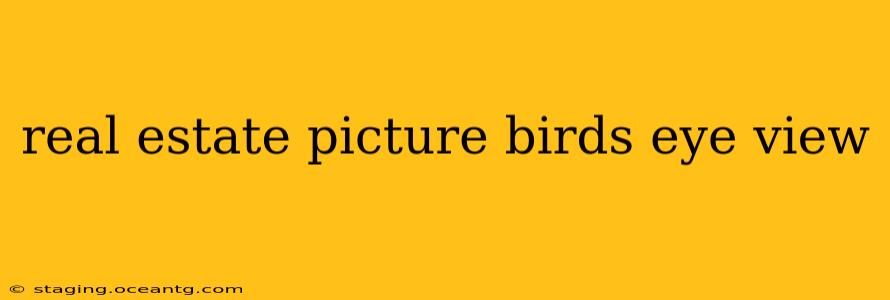Capturing stunning real estate photography requires more than just pointing a camera at a property. A bird's-eye view, also known as an aerial view, offers a unique perspective that can significantly enhance your listings and attract potential buyers. This comprehensive guide will explore the techniques, benefits, and considerations involved in achieving captivating bird's-eye views for real estate.
Why Use a Bird's-Eye View in Real Estate Photography?
A bird's-eye perspective provides a compelling visual narrative that traditional photography simply can't match. It showcases the property's context within its surroundings, highlighting its size, layout, and relationship to neighboring properties and landscape features. This holistic view is incredibly beneficial for marketing, allowing potential buyers to quickly grasp the property's overall appeal and value proposition.
What Equipment Do I Need for Aerial Real Estate Photography?
The technology for capturing aerial shots has become increasingly accessible. Several options exist, each with its advantages and disadvantages:
-
Drones: Drones are the most popular choice for many real estate photographers. They offer flexibility, maneuverability, and high-quality image capture. Ensure you comply with all local drone regulations and obtain necessary permits before flying.
-
Helicopters/Planes: For extremely large properties or expansive views, a helicopter or plane might be necessary. This option is significantly more expensive but provides unparalleled coverage and perspective.
-
High-rise Buildings/Elevated Positions: In some cases, you may be able to capture a bird's-eye view from a nearby high-rise building or other elevated position. This is a more budget-friendly alternative, but it limits your flexibility and angle options.
How to Get the Best Bird's-Eye View Shots?
Achieving professional-quality aerial real estate photography requires careful planning and execution:
-
Lighting: Golden hour (sunrise and sunset) typically provides the most flattering light for photography. Avoid harsh midday sun, which can create harsh shadows and reduce image quality.
-
Composition: Frame your shots carefully to emphasize the property's key features. Consider using leading lines to draw the viewer's eye towards the house. Experiment with different angles and perspectives to find the most captivating composition.
-
Post-Processing: Post-processing is crucial for enhancing the final images. Adjusting brightness, contrast, and color balance can significantly improve the overall aesthetic appeal. However, avoid over-processing, which can make the images look unnatural.
-
Weather Conditions: Always check the weather forecast before shooting. Windy conditions can make it challenging to control a drone, while rain or clouds can significantly impact image quality.
What are the Best Practices for Real Estate Aerial Photography?
-
Safety First: Prioritize safety when operating drones or working from elevated positions. Always follow safety guidelines and regulations.
-
Obtain Permissions: Secure necessary permissions from property owners and relevant authorities before conducting aerial photography.
-
Edit Carefully: Enhance, but don't manipulate, your images. Authenticity is crucial for building trust with potential buyers.
What are the Legal Considerations for Aerial Real Estate Photography?
-
Drone Regulations: Familiarize yourself with all local, state, and federal regulations regarding drone operation. This includes airspace restrictions, registration requirements, and privacy concerns.
-
Privacy Laws: Respect the privacy of individuals and avoid capturing images of people without their consent.
-
Property Rights: Ensure you have the necessary permissions from property owners before conducting aerial photography on their property.
How Much Does Aerial Real Estate Photography Cost?
The cost of aerial real estate photography varies considerably depending on factors such as location, equipment used, the complexity of the shoot, and the post-processing required. Prices can range from a few hundred dollars to several thousand for large-scale projects.
Are there Alternatives to Drone Photography for Aerial Views?
While drones are the most common method, alternative techniques exist, such as using a high-rise building, hiring a helicopter, or using a 3D model created from ground-level images. The best method will depend on your budget and the specific requirements of the property.
By mastering the art of bird's-eye view photography, you can significantly elevate your real estate listings and achieve exceptional results. Remember that safety, legality, and professional execution are key to success in this specialized area of real estate marketing.
